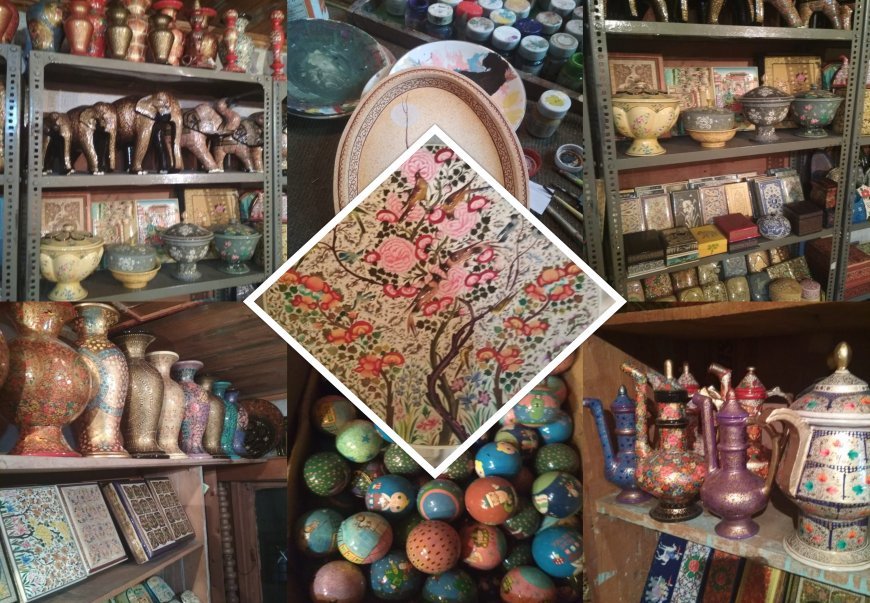Heritage of Kashmir : Art of Papier Mache

There is a very famous saying in Kashmir “Gar firdaus, ruhe zamin ast, hamin asto, hamin asto, hamin asto” (If there is ever a heaven on earth, it is here, it is here, it is here). Some of the noticeable things are picture-perfect landscape, charming lakes, mountains covered in snow, the most poetic and fairytale-like Autumn. Not only natural beauty but also the Kashmiri tradition and culture is rich and unique, ranging from food, Sufi music, art, and crafts. In short, Kashmir is heaven on earth from all perspectives.
Some of the very famous and renowned Kashmiri arts and crafts are Papier Mache, Khatamband, Pashmina shawls, Copperworks, and Woodworks.
Due to globalization and the impact of western culture, these crafts are completely getting ignored. It made life tough for the artisans, who were left to live in an atmosphere of despair, lack of resources, and opportunity. As a result, these art forms are dying.
History of Papier Mache Art:
Kashmiri Papier Mache was brought by Muslims saint Mir Sayyid Ali Hamadani from Persia in the 14th century to ancient India. The craft was initially known in Kashmir as kar-i-qalamdan as being limited to the ornamentation of cases, which is used for keeping pens and other small personal articles. This craft was also known as kar-i-munaqqash since it is used for ornamenting smooth surfaces made of paper pulp.
Process:
The process of making Papier Mache is very lengthy and required a lot of hard work and craftsmanship. First, the class of people called Sakhta Makers process waste paper, cloth, rice straw, and copper sulfate and crushed them into a pulp. Next, a wooden or brass molds are used to give it the required shape. When the pulp dries, it is rubbed and smoothened with the help of stone and a wooden file called "kathwa". The paste of glue and chalk is applied inside and outside with the help of a brush. When the glue and chalk coat dries, artisan once again rubs the surface with an even piece of brick called "kurket". Then, the piece of paper is pasted on the article with the help of glue to make the surface secure against cracks. The article is rubbed and smoothened again to get the ground (zamin) color.
After that, outlines are drawn with "zarda" or yellow color. The space outlined for floral work is stained with aster and white paint, then the floral work is painted in different colors. The opening work called "partaz" is done with any appropriate color suitable for an article. If the floral work is to be done in gold and silver, then the surface left for such work is applied with "dor", a preparation made of zarda mixed with glue and sugar. Gold and silver leaves are applied over it and the leave sticks only to those parts where "dor" is applied. When thoroughly set, the whole article is varnished with "kahruba" (amber) or "sandirus" (copal) dissolved in methylated spirit. It is then kept in the sun to dry. After it dries, the surface is rubbed with a wet cloth and washed clean, and further detailing is done. The surface of the article is polished by rubbing it with a piece of "yashm" stone (jade).
Finally, another coating of varnish is applied and the article is dried in the sun. Wood is also a very popular base for the Papier Mache work.
Painting:
In earlier days of this craft mineral, organic and vegetable colors were used to paint the articles, these days distemper colors or poster colors are used after mixing with some glue to fix the color to the ground. The brush for painting articles is made from the hair of cat, goat, or ass.
Design:
The elements used in Papier Mache are objects of nature like flowers and birds, particularly kingfisher and bulbul, historical figures, animals, hunting and battle scenes, court scenes influenced by miniature painting. Papier Mache's object reflects a very subtle grammar of motif and style. Popular patterns or design motifs are the traditional "hazaraor" or "thousand flowers" and ''gulandergul'' or "flower within flower". The chinar leaf, the iris, the Persian rose, the almond and cherry blossom, the tulip, narcissus are popular motifs.

Papier Mache craft is in extinction :
This craft is dying and diminishing art form, which requires fresh and sincere effort to revive. Kashmiri art has been passed on in families from generations, but now the inheritors are forced to leave it and explore other sources of living to feed their families.
The negligence and the indifference of the government towards the art and craft sector, missing recognition, unprecedented downfall of trade in the market eventually cause the loss of interest among the younger generation are the reason for diminishing. Lack of resources, opportunity, and sales has forced many Kashmiri artisans to give up their passion and look for other options.
A rendezvous with a Kashmiri artisan Shri Syed Maqbool Hussain
Shri Syed Maqbool Hussain won the State Award in 2013, the national award in 2014 for Papier Mache. He received a National award by the president of India in a grand commemoration honoring artisans from across the country in New Delhi. He got this honer for a classic vase, which he took six months to complete, and has the entire Mughal emperors painted across its body.
He is born on 15th January 1960 in Srinagar and learned this craft from his father. He has 45 years of experience and is a prolific painter and Papier Mache artist. He is not only gained expertise in traditional work but also made some innovations in this craft. He taught this unique craft to more than 70 students and making his contribution in spreading this craft to the younger generation.


Leave your comment
Note: HTML is not translated!